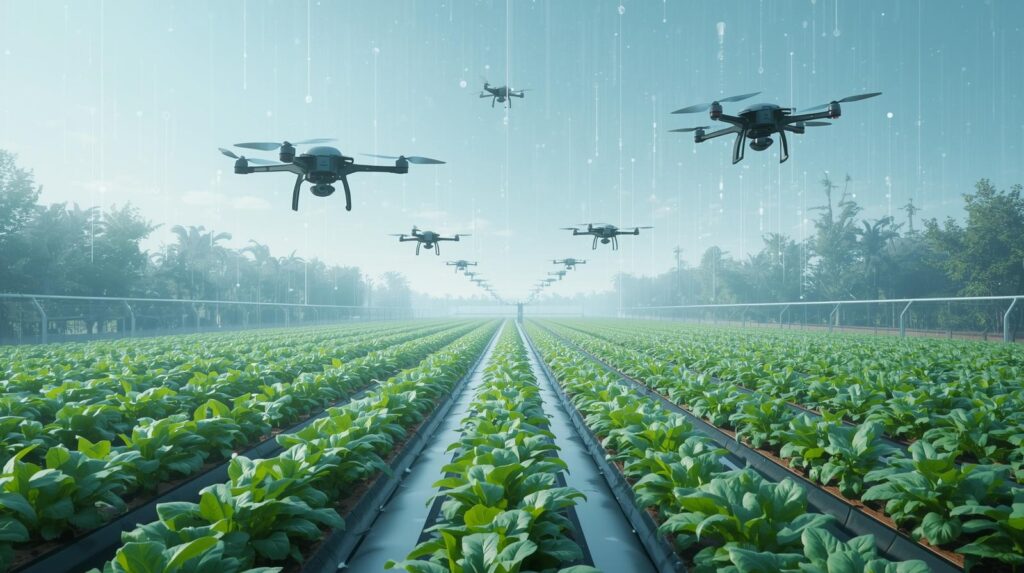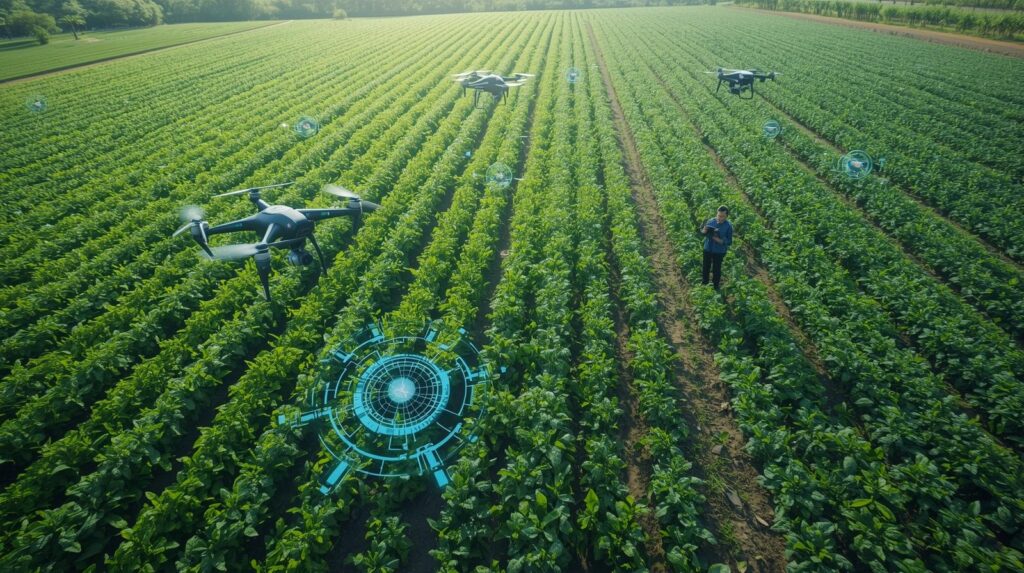The timeless art of farming is undergoing a radical transformation, shifting from a reliance on intuition and tradition to a data-driven, precise science. At the heart of this revolution is the Internet of Things (IoT), a network of interconnected devices that collect, transmit, and analyze data. The Agriculture IoT market, often called Smart Farming or Precision Agriculture, is not just a niche trend; it is the bedrock of the future of food production. This article delves deep into the future of the Agriculture IoT market, exploring the technologies, applications, challenges, and profound impacts that will define the next decade of farming.
Understanding the Agriculture IoT Ecosystem
At its core, Agriculture IoT involves deploying sensors, actuators, drones, and other devices across agricultural operations. These devices gather real-time data on a multitude of variables, including soil moisture, nutrient levels, crop health, livestock vitals, and microclimate conditions. This data is then sent to a central platform, often cloud-based, where it is processed and analyzed. The insights generated empower farmers to make hyper-informed decisions, optimizing resources and maximizing yields. The future of the Agriculture IoT market hinges on making this cycle more efficient, affordable, and accessible.
Key Drivers Fueling Market Growth
Several powerful forces are converging to accelerate the adoption of IoT in agriculture. The global Agriculture IoT Market size was estimated at USD 8.50 billion in 2024 and is predicted to increase from USD 8.86 billion in 2025 to approximately USD 12.61 billion in 2030, expanding at a CAGR of 7.3% from 2025 to 2030. This must be achieved without a proportional increase in arable land, making productivity gains essential. Climate change introduces greater volatility in weather patterns, forcing farmers to seek adaptive technologies. Simultaneously, a growing labor shortage in rural areas worldwide is creating a demand for automation. Consumer demand for transparency and sustainable food sourcing is also pushing producers to adopt traceability solutions, a key offering of IoT systems.

Pivotal Technologies Shaping the Future
The future of the Agriculture IoT market will be built on a stack of advanced technologies that work in concert. Artificial Intelligence (AI) and Machine Learning (ML) are the brains of the operation, moving beyond simple data collection to predictive analytics. They can forecast pest outbreaks, predict optimal harvest times, and prescribe precise treatment plans. Beyond AI, several other technologies are critical. Advanced sensors are becoming cheaper and more robust, capable of measuring an ever-wider range of parameters. Drones and autonomous tractors are moving from novelty to necessity, handling tasks from planting to spraying with pinpoint accuracy. The rollout of 5G and Low-Power Wide-Area Networks (LPWAN) like LoRaWAN ensures that even the most remote fields can have reliable, high-bandwidth connectivity.
Precision Farming and Smart Greenhouses
Precision farming is the most prominent application of IoT. It treats a field not as a single uniform plot, but as a collection of micro-plots, each with its own needs. IoT enables this through variable rate technology (VRT), which allows farmers to apply water, fertilizer, and pesticides only where needed and in the exact required quantities. This maximizes input efficiency, boosts yields, and drastically reduces environmental runoff. Similarly, smart greenhouses use IoT systems to autonomously control climate, irrigation, and lighting. Sensors monitor conditions and actuators adjust them automatically, creating a perfect growth environment year-round without constant human intervention.
Livestock Monitoring and Management
The future of the Agriculture IoT market extends beyond crops to animal husbandry. Smart collars and ingestible sensors monitor the health, location, and activity of livestock in real-time. This technology can provide early warnings of illness, detect estrus cycles for optimized breeding, and prevent theft by tracking herd movements. This leads to healthier animals, higher productivity, and improved animal welfare. It also reduces the need for constant physical checks, saving significant time and labor for farmers.
The Critical Role of AI and Big Data Analytics
Data is the new soil of agriculture. An IoT farm generates terabytes of data, but its value is unlocked only through analysis. AI algorithms analyze historical and real-time data to build models and make predictions. For instance, they can correlate soil moisture data with weather forecasts to create optimal irrigation schedules or analyze satellite imagery to identify areas of nutrient deficiency. This progression from descriptive analytics (what happened) to diagnostic (why it happened) and finally to prescriptive analytics (what to do about it) represents the true future of the Agriculture IoT market, turning farmers into data-driven decision-makers.
- Predictive yield modeling allows for better financial planning and supply chain management.
- Automated anomaly detection flags sick animals or failing crops faster than the human eye.
- Resource optimization algorithms ensure every drop of water and gram of fertilizer is used effectively.
Addressing Market Challenges and Barriers
Despite its immense potential, the path forward is not without obstacles. The high initial investment cost for hardware, software, and infrastructure remains a significant barrier for many smallholder farmers. Data security and privacy are major concerns, as farm data is highly valuable and potentially vulnerable. The lack of digital literacy and resistance to change within the farming community can slow adoption. Furthermore, the issue of interoperability—ensuring devices from different manufacturers can communicate seamlessly—is crucial for building a unified, efficient farm management system. Tackling these challenges is essential for the widespread success of the future of the Agriculture IoT market.
Sustainability and Environmental Impact
IoT is a powerful tool for sustainable agriculture. By enabling precise application of inputs, it minimizes the use of water, fertilizers, and pesticides, reducing chemical runoff into waterways and lowering the carbon footprint of farming operations. It also promotes soil health by preventing over-tilling and enabling better crop rotation planning. In essence, the future of the Agriculture IoT market is inextricably linked to climate-smart agriculture, helping to create a farming system that is not only more productive but also more resilient and environmentally responsible.
Global Market Trends and Regional Adoption
The adoption of Agriculture IoT is progressing at different rates across the globe. North America and Europe are currently the leading markets, driven by large farm sizes, advanced technological infrastructure, and strong government support. However, the Asia-Pacific region is expected to witness the fastest growth in the future of the Agriculture IoT market. Countries like China and India, with their massive populations and significant governmental initiatives towards modernizing agriculture, represent immense potential. In developing regions, solutions are often focused on mobile-based alerts and cost-effective sensors to ensure accessibility.
The Economic Impact on Farming
The economic model of farming is evolving with IoT. While the upfront costs are notable, the return on investment (ROI) is compelling. Farmers can achieve significant cost savings through reduced input waste, lower labor costs via automation, and decreased losses from disease and poor yields. Higher-quality produce and traceability also command better prices in the market. Ultimately, IoT shifts farming from a high-risk, guesswork-dependent business to a optimized, predictable, and profitable enterprise.

Future Outlook: The 2030 Vision
By 2030, the future of the Agriculture IoT market will likely mature into a fully integrated, autonomous ecosystem. We can expect to see the rise of fully automated farms where swarms of robots handle everything from planting to harvesting. Blockchain technology will be integrated with IoT for immutable food traceability, allowing consumers to scan a QR code and see the entire journey of their produce. AI will become even more sophisticated, moving from farm-level management to regional and global predictive systems that can forecast food shortages and optimize global supply chains. The farmer’s role will evolve from operator to manager, overseeing a fleet of smart machines and data streams.
The future of the Agriculture IoT market is bright and indispensable. It represents a paradigm shift in how we cultivate our land and raise our livestock. By harnessing the power of connectivity, data, and intelligence, IoT addresses the grand challenges of food security, sustainability, and farm profitability. While hurdles remain, the relentless pace of technological innovation and growing global need will continue to drive adoption. The farms of the future will be interconnected, intelligent, and sustainable, ensuring that we can nourish generations to come while stewarding our planet’s resources. The seeds of this connected harvest are being planted today.
Explore In-Depth Semiconductor & Electronics Market Research: https://www.marketsandmarkets.com/semiconductorand-electonics-market-research-87.html
FAQs
1. What is the Agriculture IoT Market?
The Agriculture IoT market encompasses all technologies and solutions involving networked sensors, devices, and software used to monitor, automate, and optimize agricultural operations, a practice also known as Smart Farming.
2. How big is the Agriculture IoT market expected to be?
The global Agriculture IoT Market size was estimated at USD 8.50 billion in 2024 and is predicted to increase from USD 8.86 billion in 2025 to approximately USD 12.61 billion in 2030, expanding at a CAGR of 7.3% from 2025 to 2030.
3. What are the main benefits of using IoT in agriculture?
Key benefits include increased crop yields and quality, significant resource conservation (water, fertilizers), reduced operational costs, enhanced livestock management, data-driven decision-making, and improved environmental sustainability.
4. What is the biggest challenge facing the adoption of Agriculture IoT?
The high initial investment cost is a major barrier for many farmers, especially smallholders. Other significant challenges include data privacy concerns, the need for reliable rural internet connectivity, and a lack of digital skills among some farming communities.
5. How does IoT contribute to sustainable farming?
IoT promotes sustainability by enabling precision agriculture, which minimizes the overuse of water, chemicals, and fertilizers. This reduces environmental pollution, conserves vital resources, and helps maintain soil health for long-term productivity.
6. Will AI replace farmers?
No, AI and IoT will not replace farmers but will transform their role. Farmers will evolve into farm managers or data analysts, using technology to make better decisions, manage automated systems, and focus on strategic planning rather than manual labor.
See The Latest Semiconductor Reports:
Quantum Computing Market Size, Share & Trends : https://www.marketsandmarkets.com/Market-Reports/quantum-computing-market-144888301.html
Cold Chain Monitoring Market Size, Share & Trends : https://www.marketsandmarkets.com/Market-Reports/cold-chain-monitoring-market-161738480.html
Printed Electronics Market Size, Share & Trends : https://www.marketsandmarkets.com/Market-Reports/printed-electronics-market-197.html
Head-up Display (HUD) Market Size, Share & Trends : https://www.marketsandmarkets.com/Market-Reports/head-up-display-hud-market-684.html
Mining Automation Market Size, Share & Trends : https://www.marketsandmarkets.com/Market-Reports/mining-automation-market-257609431.html